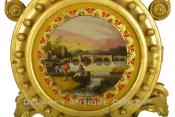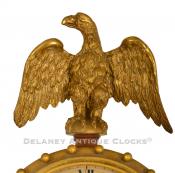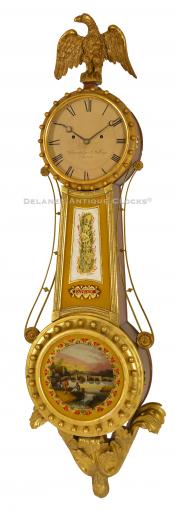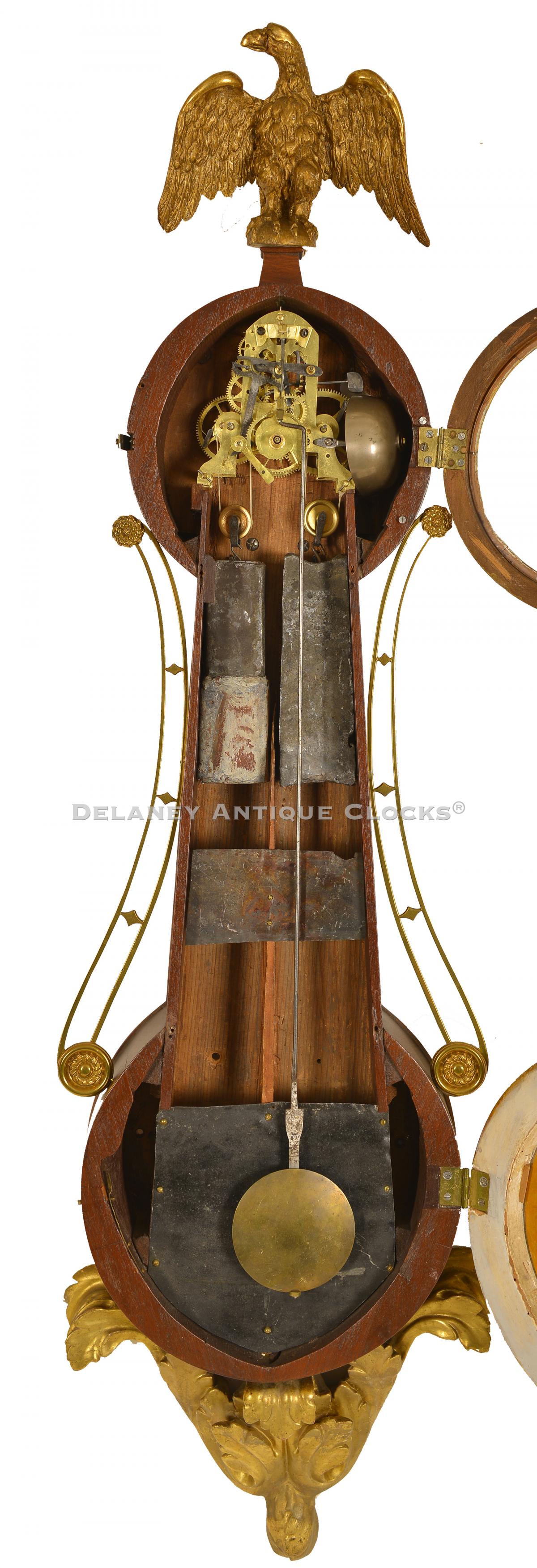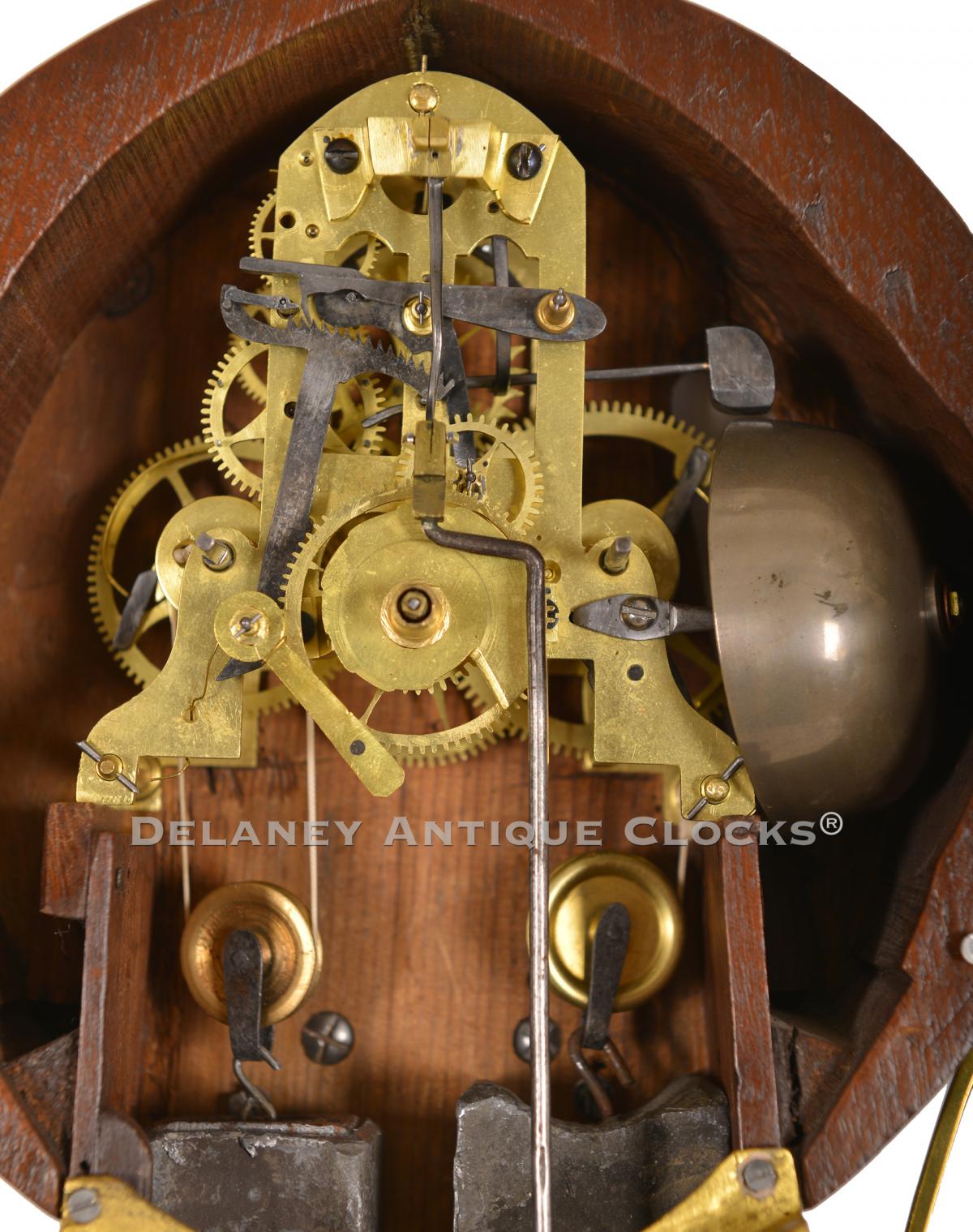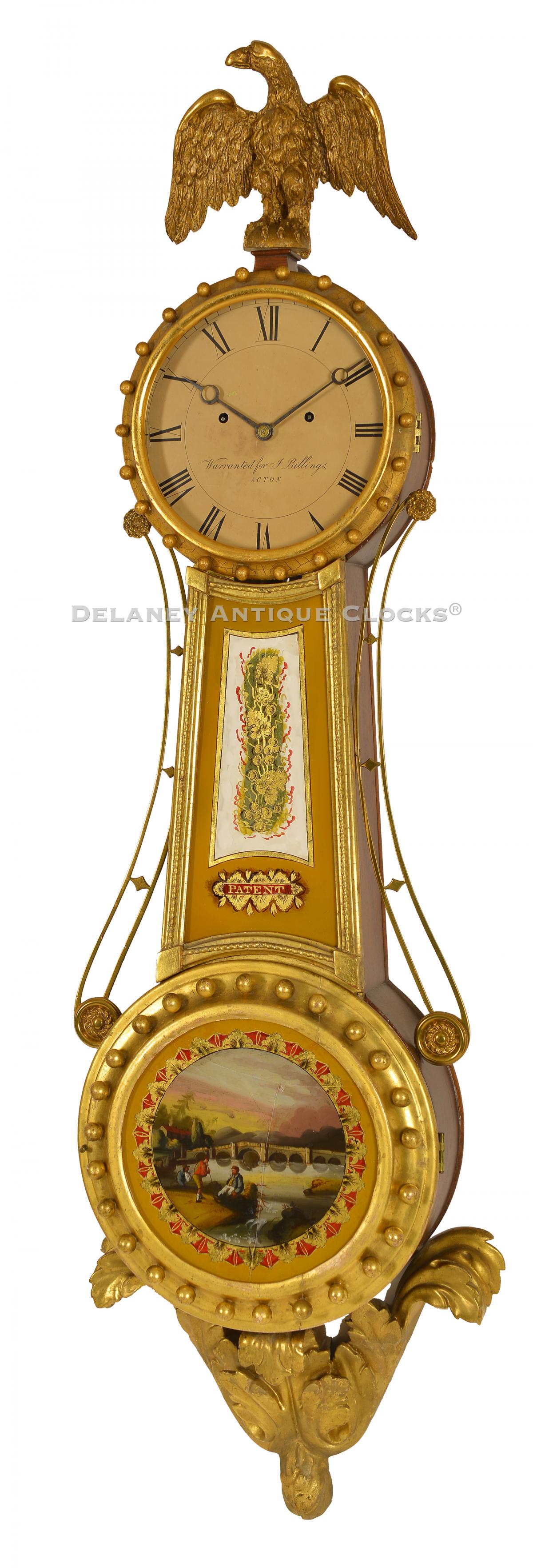Jonathan Billings, Acton & Concord, Massachusetts. A federal gilt gesso & mahogany girandole clock featuring a time and strike movement. 222096.
In the early 1800s, Lemuel Curtis, a high-skilled apprentice of the Willards, was working in Boston. In 1811, Curtis moved to Concord, MA, and set up his own shop as a Clockmaker. Here he specialized in timepieces and made a couple of improvements to Simon Willard's original 1802 patent Timepiece design. One example of this is how Curtis secured the movement in the case. He employed a single screw from the back that passed through the backboard and fastened to the backplate of the works. Curtis' ultimate achievement would have been the design of the girandole form. The girandole is often considered America's most beautiful clock. Unfortunately, it was not a financial success. As a result, a small number were originally produced. Several girandoles are now in the collections of our Country's best Museums.
Jonathan Billings was also working in Concord when Curtis introduced this form. Billings must have been intrigued with this model since he made at least two examples of his own. Both of these clocks are very similar in form. In addition, they share similar dimensions and movement configurations. However, they differ from the Curtis examples in that the Billing's made clocks are slightly smaller in scale, and both feature time and strike movements.
The Billings example offered here is well-known to the clock-collecting community. Much of its original provenance is known. It was originally passed down through the Bates Family of Boston. This clock was reported to have been originally owned by Caleb Bates (1774-1820). Caleb was involved in the China Trade as a ship owner and captain of the Juno based in Boston. From 1807-1814, Bates spent time in St Petersburg, Russia. He was also recorded as buying and shipping Russian goods during the War of 1812 and Napoleon's campaign. Caleb Bates died in 1821.
This rare clock has undergone a fair amount of restoration since 2008, when it appeared last at a public sale in Portsmouth, NH, as an already restored clock. All of this work has been performed because the clock warrants it. First-period girandole clocks, in general, are very rare. Therefore, this restored period variant should have a stronger following than the late 20th-century reproductions made by the likes of Stennes, Burleigh, Campos, and Klien.
This case measures forty-five inches long and is constructed in mahogany and pine. The mahogany sides are finished with shellac. The carved eagle finial, frames, wooden bezel, and bracket are prepared with gesso and finished in gold leaf. This work is expertly done and is of the finest quality. The gilding is in very good overall condition. The wooden carved eagle, although period, is not the ornament that his clock first appeared with at that sale in 2008. The reverse-painted tablets are colorful. The throat is signed "PATENT" in the banner at the bottom of the glass. This may suggest that Curtis licensed Billings to make this clock. The inclusion of the word PATENT also helps us date this example to after 1816. The large circular lower tablet depicts a river scene. Three gentlemen are working on a dam in the foreground. Behind them is a long bridge that crosses over the pond. The coloring and detailing are first-rate. Unfortunately, this original glass has suffered some damage. It is cracked in several locations. We have had it expertly glued back together and restored at considerable expense by one of the Country's best conservators. It is now stable and in sound condition, preserving it for generations to come. The center of the panel retains its original artwork. The mustard yellow field is a recent restoration. All of this work has been performed because the clock warrants it. The reverse-formed sidearms applied to the sides of the case are brass. The ends are capped with brass decorations.
The dial is painted on metal. It has been professionally repainted before the 1980s. It is signed "Warranted for J. Billings / Acton." The clock's hands are categorized as an "open moon" form having large circles and pointers.
Behind the dial is the distinctively shaped brass-made movement. The plates are unusual, have a distinctive shape, and have been aggressively skeletonized. The works feature two trains, and both are weight powered. It is designed to run for eight days. The lead drive weights descend side-by-side below the works through the throat of the case. This movement is supported on a seatboard and mounted to the back of the case with two screws. The steel pendulum rod supports a brass-faced bob. The pendulum tie-down is in place.
This clock is approximately 46 inches long, 13 inches wide, and 6 inches deep.
This is a very attractive example designed to impress all that view it, near or far.
Inventory number 222096.
The Acton and Concord, Massachusetts Clockmaker Jonathan Billings was born in 1777 and died in Acton on February 13, 1841. It is not currently known who trained him, and a significant number of the movements that he made do not resemble the work of other local Makers. The movement plates he designed in a number of his clocks feature a very unusual shape. They are often oversized and aggressively skeletonized. A high percentage of his wall clocks are striking clocks. These movements feature both countwheel and rack and snail striking systems. In 1818, while working in the village of Acton, he advertised himself as a watchmaker. In 1821, he moved to Concord and is working on the Milldam from 1822 through 1823. This is interesting to note because many other clockmakers were also working there. It appears that Billings stayed in Concord until he died in 1841. Billings is known to have made Patent Timepieces, striking banjo clocks, several Girandole clocks, and tall case clocks.
For more information regarding wall timepieces, please read Paul J. Foley’s book, “Willard’s Patent Time Pieces.”



